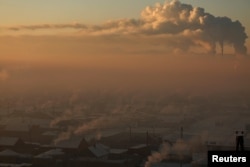Demand for natural gas is expected to be higher than the demand for coal by the year 2030.
The International Energy Agency (IEA) reported on Tuesday that, 12 years from now, gas will be the world’s second largest energy fuel, after oil. This would be a result of efforts to reduce air pollution and increased use of liquefied natural gas, the agency predicted.
The IEA report said that energy demand would grow by more than 25 percent between 2017 and 2040 if people use energy more efficiently. Demand would rise by at least 50 percent without such improvements, it added.
The estimates are based on the IEA’s “New Policies Scenario” model. It considers legislation and policies to reduce pollution and fight climate change. The estimates also consider more energy efficiencies in fuel use, buildings and other things.
The report said, “Natural gas is the fastest growing fossil fuel in the New Policies Scenario, overtaking coal by 2030 to become the second-largest…energy after oil.”
China is currently the biggest oil and coal importer in the world. It would soon become the largest importer of gas, the IEA predicted. The report said that the level of Chinese imports would be similar to those of the European Union by 2040.
The Reuters news agency examined information from China’s General Administration of Customs. Reuters found that China is already importing more natural gas than Japan, the world’s top importer of gas.
China is the world’s third-biggest user of natural gas, following the United States and Russia. China imports about 40 percent of its natural gas because local production cannot provide as much as the country needs.
Developing economies in Asia make up about half of worldwide gas demand growth. Their share of liquefied natural gas imports would double to 60 percent by 2040, the IEA report said.
When gas is cooled, it can be turned into a liquid and transported by ship.
The report noted the demand for natural gas is not yet as great as the demand for oil. But it said gas is now being shipped to new markets.
Coal and carbon
The United States could be responsible for 40 percent of total gas production growth until 2025, the IEA said. But U.S. companies are recovering less gas from shale rock formations. The report noted that other nations are turning to untraditional methods of gas production, such as fracking.
Worldwide electricity demand will grow 2.1 percent a year, mostly pushed up by greater use in developing countries. Electricity will make up 25 percent of energy used by consumers and businesses by 2040, it said.
The IEA believes that the use of coal will fall from about 40 percent today to 25 percent in 2040. Wind power and other renewable energy would grow to over 40 percent during the period.
However, the world’s coal-burning power centers cause 33 percent of energy-related carbon dioxide (CO2) emissions. Many of those power plants are in Asia, where average coal plants are usually about 11 years old with many years left to operate. In the United States and Europe, coal plants operate for about 40 years.
The IEA’s executive director said there are ways to contain the pollution that comes from liquefied natural gas. But it would take an international agreement on economic policies.
The IEA said energy-related CO2 emissions could reach a record high this year. They will continue to grow at a slow rate up to 2040.
From 2017 levels, the IEA said emissions would rise by 10 percent to 36 gigatonnes in 2040 because of the growth in oil and gas.
The report said these efforts barely begin do what the scientific community believes must be done to stop climate change.
I’m Jonathan Evans.
The Reuters news agency reported this story. Susan Shand adapted the report for VOA Learning English. The editor was George Grow.
Write to us in the Comments Section or on our Facebook page.
_______________________________________________________________
Words in This Story
efficient – adj. capable of producing desired results without wasting materials, time, or energy
scenario – n.a description of what could happen
emission – n.the act of producing or sending out something (such as energy or gas) from a source
fossil – n.something left in or on the ground from ancient times
consumer– n.someone who purchases goods or uses something
scenario– n.a written description of a story or a series of developments
fracking –n. a method used for getting oil and gas from underground rocks by injecting liquid into the rocks so that they break apart
gigatonnes – n.a unit of explosive force equal to one billion tons of TNT










